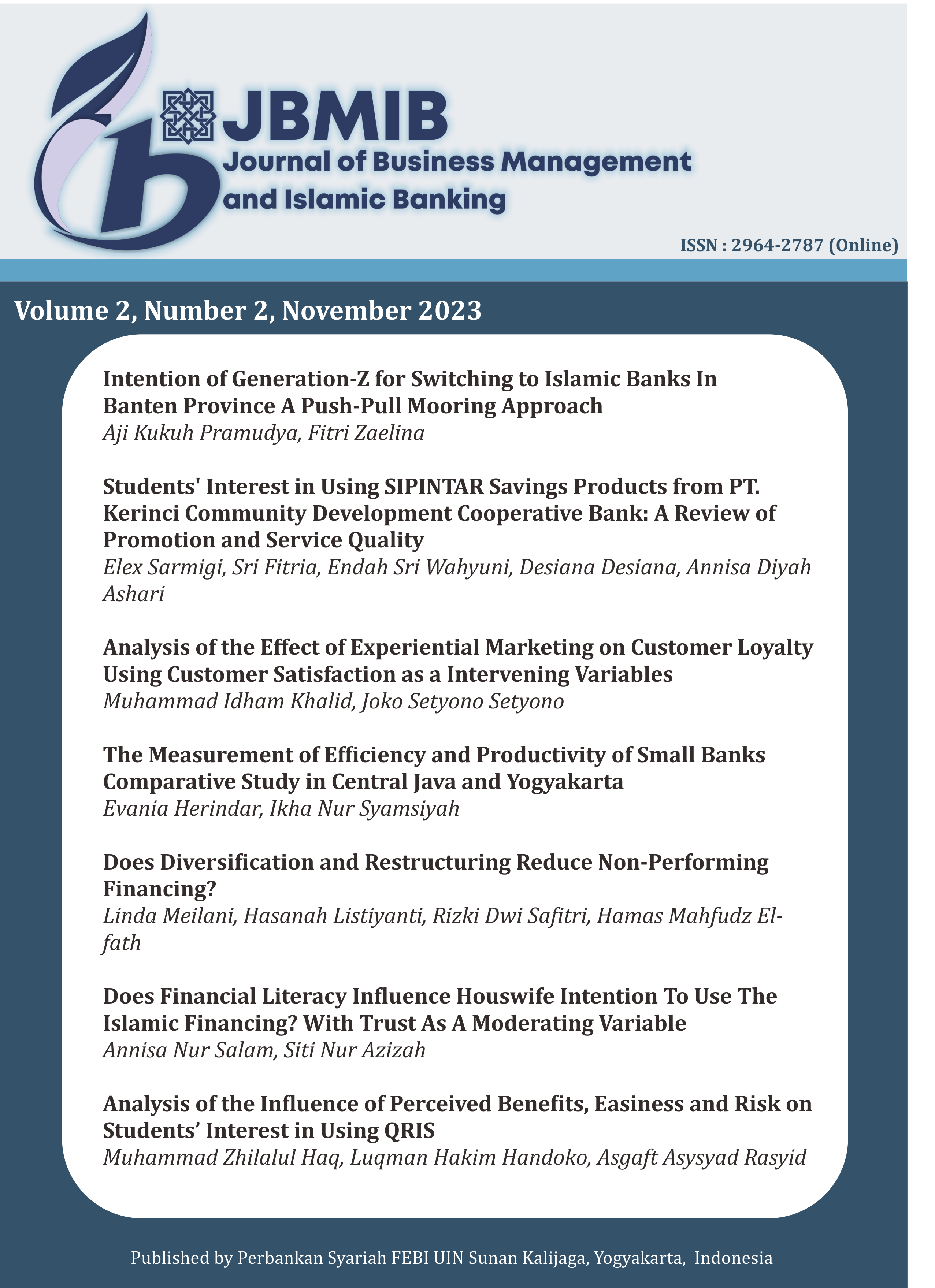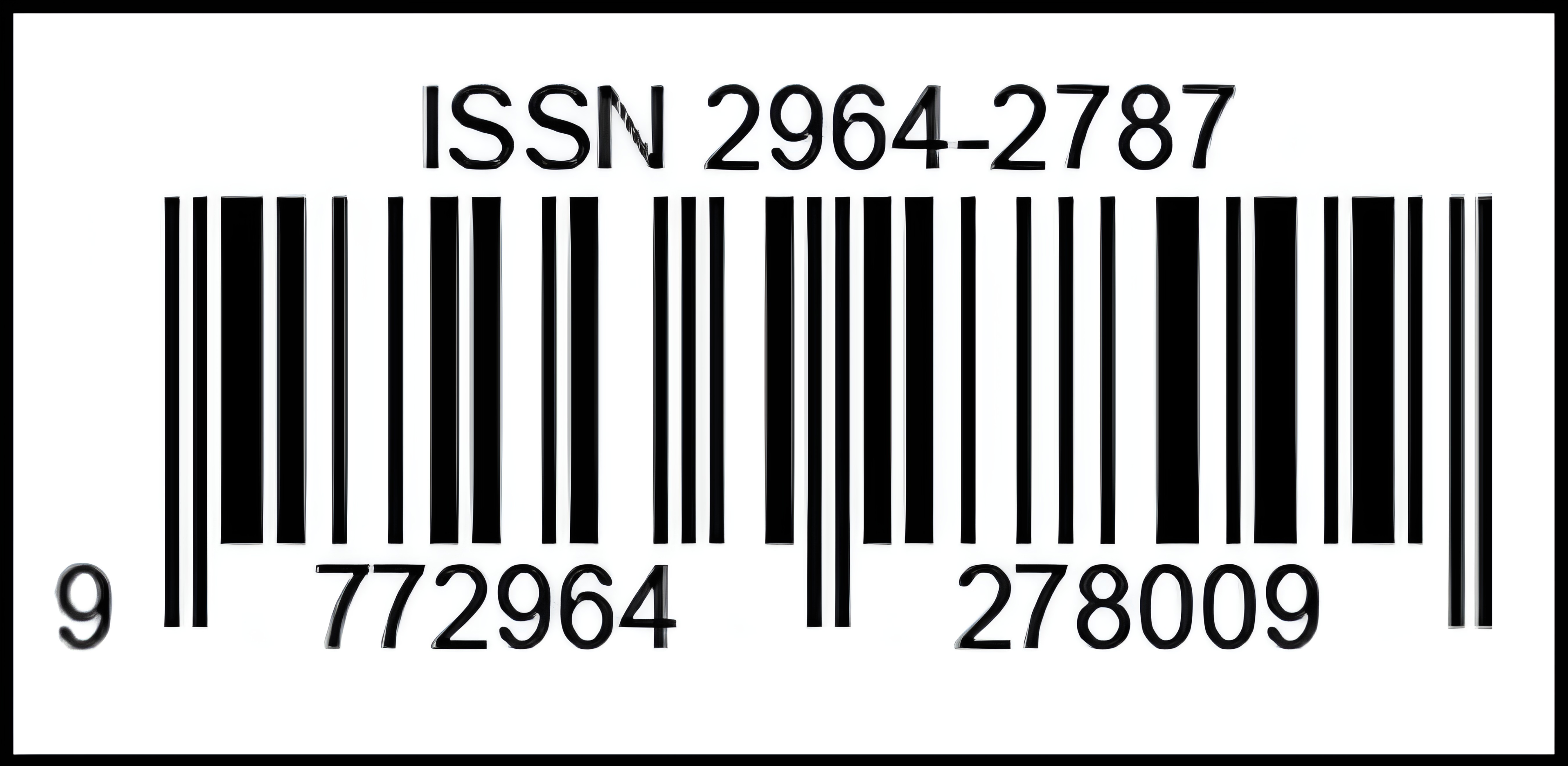The Measurement of Efficiency and Productivity of Small Banks Comparative Study in Central Java and Yogyakarta
DOI:
https://doi.org/10.14421/jbmib.v2i2.2071Keywords:
Rural Bank, Islamic Rural Bank, Efficiency, ProductivityAbstract
Research Aims: The purpose of this study was to determine the effect of promotion and service quality on students' interest in choosing SIPINTAR products at PT. Bank Perkreditan Rakyat Pembangunan Kerinci.
Methodology: This study uses a quantitative research design with a survey approach. The research sample was 60 students in Kerinci Regency while the sampling technique was the convenience sampling method. The data analysis technique used multiple linear analysis, while the hypothesis testing used the statistical t test and F test with the help of the IBM SPSS 26 application.
Research Findings: The results of this study found that partially promotion had a positive and significant effect on students' interest in using SIPINTAR products, while service quality had no effect on students' interest in using SIPINTAR PT. Kerinci Development People's Credit Bank. The results of the F test show that promotion and service quality simultaneously have a significant effect on using PT. SIPINTAR products. Kerinci Development People's Credit Bank, with the magnitude of this influence, namely 20.6%.
Theoretical Contribution: This research is beneficial for the development of the banking business, especially for regional banks.
Research limitation and implication: This study has limitations, namely only examining promotion factors and service quality in influencing the intention to save. However, the results of this study provide information that promotion is a factor in forming interest in using banking products.
Downloads
 Abstract viewed: 177 times
|
Abstract viewed: 177 times
|
 PDF downloaded = 285 times
PDF downloaded = 285 times
References
Adeabah, D., & Andoh, C. (2020). Cost efficiency and welfare performance of banks: evidence from an emerging economy. International Journal of Managerial Finance, 16(5), 549-574.
Abbas, M., Hammad, R. S., Elshahat, M. F., & Azid, T. (2015). Efficiency, productivity and Islamic banks: an application of DEA and Malmquist index. Humanomics, 31(1), 118-131.
Agustina, D., Sholihin, M., & Fithria, A. (2019). The efficiency of Indonesian Islamic rural banks: a stochastic frontier analysis. International Journal of Islamic Economics and Finance (IJIEF), 1(2), 229-248.
Ahmed, H. (2004). Frontiers of Islamic banks: A synthesis of the social role and microfinance. Munawar Iqbal Islamic Banking in Practice 10 Said M. Elfakhani, Yusuf M. Sidani and Omar A. Fahel An Assessment of the Performance of Islamic Mutual Funds 39 Obiyathulla Ismath Bacha Value Preservation through Risk Management A Shariah Compliant Proposal for Equity Risk, 118.
Al‐Muharrami, S. (2007). The causes of productivity change in GCC banking industry. International Journal of Productivity and Performance Management, 56(8), 731-743.
Anwar, M., Rahman Nidar, S., Komara, R., & Layyinaturrobaniyah, L. (2021). A comparative analysis of rural banks’ efficiency between Bali and West Java provinces in Indonesia. Journal of Sustainable Finance & Investment, 11(4), 330-350.
Arianto, B. (2021). Dampak Pandemi Covid-19 terhadap Perekonomian Dunia. Jurnal Ekonomi Perjuangan, 2(2), 106–126.
Bahrini, R. (2015). Productivity of MENA Islamic banks: a bootstrapped Malmquist index approach. International Journal of Islamic and Middle Eastern Finance and Management, 8(4), 508–528. https://doi.org/10.1108/IMEFM-11-2014-0114
Banker, R. D., Charnes, A., & Cooper, W. W. (1984). Some models for estimating technical and scale inefficiencies in data envelopment analysis. Management Science, 30(9), 1078-1092.
Barneveld, K. Van, Quinlan, M., Kriesler, P., Junor, A., Baum, F., Chowdhury, A., Junankar, P. (Raja), Clibborn, S., Flanagan, F., Wright, C. F., Friel, S., Halevi, J., & Rainnie, A. (2020). The COVID-19 pandemic: Lessons on building more equal and sustainable societies. The Economic and Labour Relations Review, 31(2), 133–157.
Charnes, A., Cooper, W. W., & Rhodes, E. (1978). Measuring the efficiency of decision-making units. European Journal of Operational Research , 429-444.
Devi, A., & Firmansyah, I. (2018). Solution To Overcome The Bankruptcy Potential Of Islamic Rural Bank In Indonesia. Journal of Islamic Monetary Economics and Finance, Volume 3.
Färe, R., Grosskopf, S., Lindgren, B., & Roos, P. (1992). Productivity changes in Swedish pharmacies 1980–1989: A non-parametric Malmquist approach. Journal of Productivity Analysis, 3(1-2),, 85-101.
Färe, R., Grosskopf, S., Norris, M., & Zhang, Z. (1994). Productivity growth, technical progress, and efficiency change in industrialized countries. The American Economic Review, 84(1), 66-83.
Fauzi, M. (2018). Efisiensi bank pembiayaan rakyat syariah (BPRS) di provinsi Jawa Tengah. Jurnal Ekonomi dan Keuangan Islam, 31-40.
Hadad, M. D. (2003). Analisis Efisiensi Industri Perbankan Indonesia: Penggunaan Metode Nonparametrik Data Envelopment Analysis (DEA). Biro Stabilitas Sistem Keuangan Bank Indonesia, Research Paper No. 7/5.
Hartono, I., Djohar, S., & Heny , K. D. (2008). Analisis Efisiensi Bank Perkreditan Rakyat di Wilayah Jabodetabek dengan Pendekatan Data Envelopment Analysis . Jurnal Manajemen dan Agribisnis.
Hersinta, D. I., & Akbar, L. F. (2013). Analisis Efisiensi Perbankan Di Indonesia Dengan Pendekatan Data Envelopment Analysis (DEA). Manajemen Usahawan Indonesia, 42(2), 119–130.
Hibatullah, I., & Nurcahyani, A. (2021). Analysis Efficiency Of Islamic Bank In Indonesia And Saudi Arabia Analysis Efficiency Of Islamic Bank In Indonesia And Saudi Arabia. Islamiconomic: Jurnal Ekonomi Islam. Vol.12
Hosen, M. N., & Warninda, T. D. (2014). Mapping of Efficiency and Profitability in Islamic Rural Bank in Indonesia. International Journal of Academic Research in Business and Social Sciences.
Iskandar. (2012). Studi Efisiensi Perbankan Syariah Di Kota Lhokseumawe dan Aceh Utara. AlTahrir, 12(1), 63-86.
Jatmiko, W. (2017). Efficiency And Ownership Structure: Evidence From Rural Banks In Indonesia. International Journal of Economics, Management and Accounting 25, no. 2.
Masyita, D., & Ahmed, H. (2013). Why is Growth of Islamic Microfinance Lower than its Conventional Counterparts in Indonesia. Islamic Economics Studies 21, no. 1, 35-62.
Naufal, F. M., & Firdaus, A. (2018). Analisis Efisiensi Bank Pembiayaan Rakyat Syariah (Bprs) Wilayah Jabodetabek Dengan Pendekatan Two Stage Data Envelopment Analysis (Dea). Equilibrium: Jurnal Ekonomi Syariah, 5(2).
Ningsih, M. R., & Mahfudz, M. S. (2020). Dampak Pandemi Covid-19 Terhadap Manajemen Industri Perbankan Syariah: Analisis Komparatif. Point, 2(1). 1- 10.
Norafni, Rahim, F., Bakri, M. H., & Yahaya, S. N. (2020). Conceptualization of Spiritual Intelligence Quotient (SQ) in the Islamic Fintech Adoption. Islamiyyat, 42(1), 113–122.
Nugrohowati, R. N. (2019). Measuring The Effciency of Indonesian Sharia Rural Banks: Two Stage Approach. Jurnal Ekonomi Pembangunan: Kajian Masalah Ekonomi dan Pembangunan.
Otoritas Jasa Keuangan. (2020). Cetak Biru Transformasi Digital Perbankan. In Departemen Penelitian dan Pengaturan Perbankan Otoritas Jasa Keuangan.
Prativi, Y. P., Dewi, D. M., & Lubis, C. (2020). Analisis Komparatif Pengukuran Kinerja Entitas Syariah Dengan Balance Scorecard Dan Maslahah Scorecard. . Jurnal Ilmiah MEA (Manajemen, Ekonomi, & Akuntansi), 4(1), 106-113.
Putra, R. R., Syifadhiya, S., Widyastiti, S. A., & Pambuko, Z. B. (2018). Analisis Produktivitas Perbankan Syariah di Indonesia dalam Mengelola Dana Sosial. JESI (Jurnal Ekonomi Syariah Indonesia).
Putri, Y. A., & Marlius, D. (2018). Analisis Tingkat Kesehatan Bank Pada PT. Bank Perkreditan Rakyat (BPR) Jorong Kampuang Tangah Pariaman Cabang Padang.
Rani, L. N., Sukmaningrum, P. S., & Salleh, M. C. M. (2020). A comparative analysis of the productivity of Islamic banking in Indonesia, Malaysia and Brunei Darussalam during the period 2012-2017. International Journal of Innovation, Creativity and Change, 11(11), 470–491.
Sadono, E. D. (2017). Efficiency of Islamic Rural Banks (BPRS) in East Java Province. TIFBR Tazkia Islamic Finance and Business Review.
Shang, H. J. and J. (2005). Productivity changes of pulp and paper industry in OECD countries, 1991–2000: a non-parametric Malmquist approach. Forest Policy and Economics, Volume 7(3), 411–422.
Samuelson, Paul, A., Nordhaus, & William, D. (2003). Ilmu Mikroekonom. Media Global Edukasi.
Seibel, H. D. (2008). Islamic Microfinance in Indonesia: The Challenge of Institutional Diversity, Regulation, and Supervision. Journal of Social Issues in Southeast Asia 23, no. 1, 86-103.
Seibel, H. D., & Dwi Agung, W. (2006). Islamic Microfinance in Indonesia (No: 2006, 2). University of Cologne. Development Research Center.
Sharma, D., Sharma, A. K., & Barua, M. K. (2013). Efficiency and productivity of banking sector: A critical analysis of literature and design of conceptual model. Qualitative Research in Financial Markets, 5(2), 1755-4179.
Suliyanto, & Jati, D. P. (2014). Perbandingan Efisiensi Bank Perkreditan Rakyat dan Bank Umum dengan Pendekatan Data Envelopment Analysis . Jurnal Keuangan dan Perbankan,Vol.18.
Warninda, T. D., & Hosen, M. N. (2015). Mapping And Correlation Analysis Of Efficiency And Profitability: The Case Of Islamic Rural Bank In Indonesia. Al-Iqtishad, Vol. VII No. 1.
Zheng, C., & Zhang, J. (2020). Since January 2020 Elsevier has created a COVID-19 resource centre with free information in English and Mandarin on the novel
Downloads
Published
How to Cite
Issue
Section
License
Copyright (c) 2023 Journal of Business Management and Islamic Banking

This work is licensed under a Creative Commons Attribution-NonCommercial 4.0 International License.












